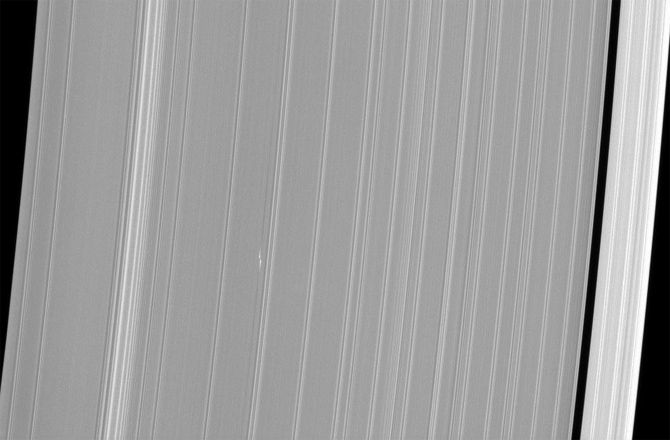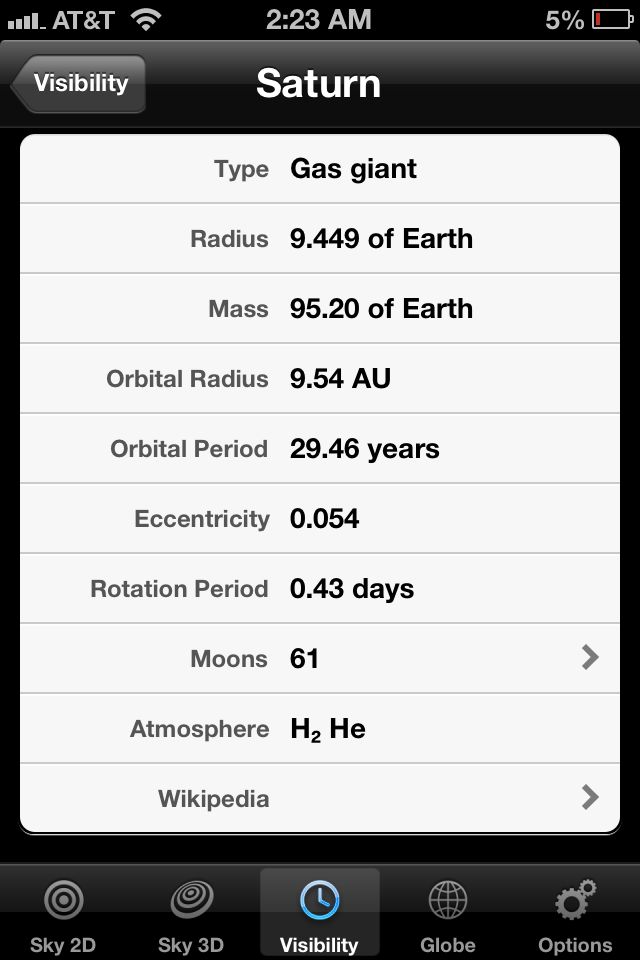It looks like you're using an Ad Blocker.
Please white-list or disable AboveTopSecret.com in your ad-blocking tool.
Thank you.
Some features of ATS will be disabled while you continue to use an ad-blocker.
15
share:
Greetings, ATS!
Discovery News is reporting that mini-moons have been discovered in the rings of Saturn.

I don't think these are moons in the traditional sense, but nevertheless I found it fascinating. Hope you enjoy.
Discovery News is reporting that mini-moons have been discovered in the rings of Saturn.
Like Jupiter, Saturn is orbited by a large extended family of moons — 62, at last count — ranging in size from the gigantic 3,200-mile-wide Titan, wrapped in thick clouds, to the barely 2-mile-wide Methone, smooth as a river rock. But there are even more moons in the ringed planet’s retinue, tiny worlds embedded inside the icy rings themselves. Even with the Cassini spacecraft they are nearly impossible to see… until they give themselves away with their shining “propellers.”

I don't think these are moons in the traditional sense, but nevertheless I found it fascinating. Hope you enjoy.
Wow just imagine the view If you could stand on it's surface
Great find smylee as usual
Great find smylee as usual
Saturn is such a beautiful planet, 62 moons and counting is fascinating to. A great share thank you One for you smylee.
Cassini took the photo which is actually a mosaic of 60 images on Oct. 17, while looking back toward the sun from a spot within Saturn's shadow.
edit on 28-2-2013 by TheDoctor46 because: (no reason
given)
Slightly bigger-than-average rock or icecube among all the other rocks and icebergs that make up the Saturnine ring system, repackaged and
consumerised to entertain the proletariat.
By this count, Saturn probably has upwards of a million 'moons'—every piece of ring that's bigger than a shoebox.
By this count, Saturn probably has upwards of a million 'moons'—every piece of ring that's bigger than a shoebox.
reply to post by smyleegrl
So what are moons exactly. As far as I understand Moons are Lunar Terrians, as our nearest moon makes evidence of such. These new claims, and indeed the newly introduced re-classification as to what constitutes as ;moon is plain dumb. More confusing tech babble that should be dismissed. Shoeboxed sized space debris are not moons.
So what are moons exactly. As far as I understand Moons are Lunar Terrians, as our nearest moon makes evidence of such. These new claims, and indeed the newly introduced re-classification as to what constitutes as ;moon is plain dumb. More confusing tech babble that should be dismissed. Shoeboxed sized space debris are not moons.
Originally posted by TheDoctor46
Saturn is such a beautiful planet, 62 moons and counting is fascinating to. A great share thank you One for you smylee.
Cassini took the photo which is actually a mosaic of 60 images on Oct. 17, while looking back toward the sun from a spot within Saturn's shadow.edit on 28-2-2013 by TheDoctor46 because: (no reason given)
SATURN does not have 62 moons.
reply to post by Tindalos2013
Yup it has 60
www.universetoday.com...
Ooops correction it does have 62 moons.
science.yourdictionary.com...
saturn.jpl.nasa.gov...
Yup it has 60
www.universetoday.com...
Ooops correction it does have 62 moons.
science.yourdictionary.com...
saturn.jpl.nasa.gov...
edit on 28-2-2013 by boymonkey74 because: (no reason given)
That's what the sources say, but I don't think so....there are over 100 if you count what's in this small sample, and probably over 1000 since we don't seem to know exactly what a moon is:
Originally posted by boymonkey74
reply to post by Tindalos2013
Yup it has 60
www.universetoday.com...
Ooops correction it does have 62 moons.
science.yourdictionary.com...
saturn.jpl.nasa.gov...
Moons of Saturn
a precise number of Saturnian moons cannot be given, as there is no objective boundary between the countless small anonymous objects that form Saturn's ring system and the larger objects that have been named as moons. At least 150 moonlets embedded in the rings have been detected by the disturbance they create in the surrounding ring material, though this is thought to be only a small sample of the total population of such objects.
I tried to find a definition of a moon, then found something called a "moonlet":
But since it's an informal term, we still have the problem of not having a good definition of a moon.
Moonlet is an informal term for a particularly small natural satellite. In astronomical literature, it has been used in at least two situations
So we need 149 more of these threads, for the remaining 149 moons/moonlets in Saturn's rings that are thought to be there, and if that's only a small sample, probably over 1000 more.
Anyone care to make a better definition of a moon? Seems like we need one, maybe using mass, or size dimension, as the cutoff for the "objective boundary between the countless small anonymous objects that form Saturn's ring system and the larger objects that have been named as moons".
reply to post by Astyanax
Your guess is as good as mine, but yes, there's a lot.
edit on 28-2-2013 by Arbitrageur because: clarification
reply to post by Arbitrageur
I am going to define a moon right now....
Lets call a moon any object orbiting a planet whose mass is greater than 1% of its "parent" planet..
Just made it up so dont know how good it is.....could have chose 5% but thought that may disallow some obvious moons around Jupiter dues to Jupiters profound size...
What do yall think?
Christosterone
I am going to define a moon right now....
Lets call a moon any object orbiting a planet whose mass is greater than 1% of its "parent" planet..
Just made it up so dont know how good it is.....could have chose 5% but thought that may disallow some obvious moons around Jupiter dues to Jupiters profound size...
What do yall think?
Christosterone
I wonder how many more planets like Saturn out there in the Universe.
The rings of Saturn are truly the gravitational bell weather of the solar system. The extremely delicate rings are arranged the only way they could
be, given the combined gravitational influence of everything substantial not only close to Saturn, but in the entire solar system itself.
If we ever started to see subtle differences in their incredible stability, then we would know beyond a shadow of doubt that we had a dangerous guest in the neighborhood. It is not only beautiful, it is a giant trouble meter!
If we ever started to see subtle differences in their incredible stability, then we would know beyond a shadow of doubt that we had a dangerous guest in the neighborhood. It is not only beautiful, it is a giant trouble meter!
Originally posted by Christosterone
reply to post by Arbitrageur
I am going to define a moon right now....
Lets call a moon any object orbiting a planet whose mass is greater than 1% of its "parent" planet..
Just made it up so dont know how good it is.....could have chose 5% but thought that may disallow some obvious moons around Jupiter dues to Jupiters profound size...
What do yall think?
Christosterone
Jupiter is pretty damn heavy, 1% may even be too little to classify any of it's moons in such a way.
1.8986×10^27 kg, that's 317.83 Earth masses, so Earth wouldn't even be considered a moon of Jupiter with that definition. Good idea, but it could get complicated. I believe Mars' moon phobos is less than 1% of it's mass as well.
edit on 2-3-2013 by Hijinx because: left out the ^
Originally posted by boymonkey74
reply to post by Tindalos2013
Yup it has 60
www.universetoday.com...
Ooops correction it does have 62 moons.
science.yourdictionary.com...
saturn.jpl.nasa.gov...
edit on 28-2-2013 by boymonkey74 because: (no reason given)
There's 61 according to my iOS app "Planets."

new topics
-
How To Spot Fake U.F.O. Photos
Aliens and UFOs: 2 hours ago -
Scary video of face in an abandoned house
Paranormal Studies: 4 hours ago -
Just Came Across These Unusual Old UFO Pics
Aliens and UFOs: 6 hours ago -
LA Mayor Bass Demanded $49M in Additional LAFD Cuts One Week Before Wildfires
Mainstream News: 8 hours ago -
Sepultura - Territory - With New Drummer Greyson Nekrutman
Music: 9 hours ago -
Carry On!
Short Stories: 9 hours ago
top topics
-
This should be plastered all over the airwaves
Mainstream News: 15 hours ago, 24 flags -
LA Mayor Bass Demanded $49M in Additional LAFD Cuts One Week Before Wildfires
Mainstream News: 8 hours ago, 17 flags -
Archbisop Vigano Warns of Deep State and Deep Church
New World Order: 17 hours ago, 16 flags -
Oh, Good Gosh. “Kremlin Warns Stay Away from Greenland.”
World War Three: 17 hours ago, 12 flags -
Just Came Across These Unusual Old UFO Pics
Aliens and UFOs: 6 hours ago, 7 flags -
Scary video of face in an abandoned house
Paranormal Studies: 4 hours ago, 5 flags -
How To Spot Fake U.F.O. Photos
Aliens and UFOs: 2 hours ago, 4 flags -
Carry On!
Short Stories: 9 hours ago, 3 flags -
Sepultura - Territory - With New Drummer Greyson Nekrutman
Music: 9 hours ago, 2 flags
active topics
-
Old School Punk
Music • 566 • : underpass61 -
-@TH3WH17ERABB17- -Q- ---TIME TO SHOW THE WORLD--- -Part- --44--
Dissecting Disinformation • 3987 • : duncanagain -
To become president, Zelensky had to learn Ukrainian
Political Conspiracies • 44 • : SteamyAmerican -
Los Angeles brush fires latest: 2 blazes threaten structures, prompt evacuations
Mainstream News • 383 • : WeMustCare -
Judge rules president-elect Donald Trump must be sentenced in 'hush money' trial
US Political Madness • 120 • : Vermilion -
This should be plastered all over the airwaves
Mainstream News • 55 • : Astrocometus -
Oh, Good Gosh. “Kremlin Warns Stay Away from Greenland.”
World War Three • 32 • : SteamyAmerican -
Candidate TRUMP Now Has Crazy Judge JUAN MERCHAN After Him - The Stormy Daniels Hush-Money Case.
Political Conspiracies • 2190 • : WeMustCare -
Iran Sympathizers in Biden Admin Leak Intelligence on Israel Attack Plans
Mainstream News • 86 • : WeMustCare -
How To Spot Fake U.F.O. Photos
Aliens and UFOs • 1 • : nugget1
15
